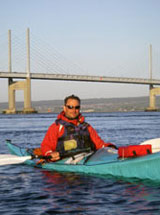Dr. Robbie Nicol, School of Education, University of Edinburgh
Sitting amongst the lush, flowering machair, this rare European habitat, I find time and space to ponder. The vast expanse of sandy beach below is empty of people who will no doubt appear a little later given the sunny forecast. For the moment I have the place to myself and the rising sun provides intermittent pulses of warmth and welcome relief from the chilly early morning air. A light south-westerly wind ruffles the papers beside me. One of these is David Farrier’s earlier blog on this site and I am fascinated by the question ‘what is the role of emotion in environmental ethics’? My own interest in this question is the extent to which experiences in the outdoors, and their dependence on direct encounters of land and waterscapes, can provide moral impulses for people to live more sustainable lives. As an educator and academic my professional life at the University is spent developing educational responses (perhaps ‘interventions’ is a more appropriate word) to this intriguing issue.
The machair itself provides some guidance in responding to David’s question. The understanding of substances, their properties and composition (chemistry) helps us understand how the shell-bearing sand created lime-rich fertile soil conditions. Botany helps with the identification of the variety of plant species currently surrounding me. History provides a record of how people came to farm this land, and from which, in the 18th Century, some of them came to be ‘cleared’ to make way for more profitable sheep. These snippets of information provide valuable knowledge of this landscape.
Creating bodies of knowledge in this way has been a cornerstone of academia as we, the world’s human inhabitants, have striven to understand our surroundings. However, thinking of knowledge in this way is part of a bigger problem. The environmental philosopher Andrew Brennan has written about the divisions which compartmentalise subject based curricula and how this leads to divisions in the way people think and make sense of the world. So, when I look at the machair surrounding me I do not really see chemistry here, biology there and history somewhere else. The danger of ‘reducing’ the land and seascape in this way is that we separate strands of knowledge that are in fact related. It is perhaps more because of institutional convenience (i.e. the way we have organised our school and educational systems) rather than philosophical principles that things have turned out this way. However, the fact that we have already done so means we run the risk of failing to understand the planet as an integrated whole. (Note: In passing it is worth noting that the Global Environment and Society Academy, GESA, is itself an institutional response to provide a forum for interdisciplinary thinking and action.)
There is a further danger that scientists (social and natural) are intimately involved with their subjects but not intimately involved with what they describe. This is one of the problems when we decontextualise studies and teach them remotely from the land and seascapes they refer to. There is a growing body of scholarly activity that suggests we can overcome these ‘second order expressions’ through direct, nature-based experiences. It is based on the view that fundamentally there is no real separation of the affective and the cognitive because they are part of the same whole (most certainly at the level of the individual human organism). It is within this understanding of epistemological diversity that the opportunity for moral impulses appear because sea and landscapes provide places in which we might develop and exercise what the environmental philosopher Simon James has termed ‘the virtue of attention’. I take this to mean that the moral significance of our relationship with land and seascapes is based, and ultimately depends on, the attention we pay to it.
Emotion is therefore centre-stage of any discussion regarding environmental ethics. I find it impossible not to be emotionally aware sitting amongst the machair. The sensorial stimuli of this amazing habitat, and the book on my lap that informs me in another way, infuses my being. At this moment, at the cutting edge of experience, I want to learn more and feel more deeply. The selfish reductionist in me does not want the moment to end and wishes to preserve it for what it means to me – forever. The holist in me appreciates that this moment will not simply pass but morph into yet other moments creating links with the past, present and future. I have been informed by thoughts and feelings of this incredible Harris landscape to the point that the machair has now become part of me. This consciousness now makes me want to speak of it and, should the need arise, act on its behalf (or should I say our behalf).
Dr Robbie Nicol is a senior lecturer in outdoor environmental education at the School of Education. His article about moral impulses (Entering the Fray: The role of outdoor education in providing nature-based experiences that matter) has been published in the journal Educational Philosophy and Theory and is available electronically. A further article (Fostering environmental action through outdoor education) has just been accepted by Educational Action Research. Robbie also co-authored Learning outside the classroom: Theory and guidelines for practice (2012).



Pingback: watershed | Joanna Dobson